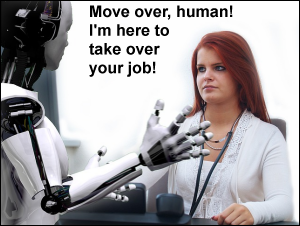 An article posted on March 3, 2017, stated that “The wage-earner robot apocalypse arrives: Wendy’s to install 1,000 fast food kiosks to replace humans”. More and more jobs are being replaced by robots. This isn’t the first time that we’ve heard about this kind of transition to automation within the fast food industry. However, it is the largest to date.
An article posted on March 3, 2017, stated that “The wage-earner robot apocalypse arrives: Wendy’s to install 1,000 fast food kiosks to replace humans”. More and more jobs are being replaced by robots. This isn’t the first time that we’ve heard about this kind of transition to automation within the fast food industry. However, it is the largest to date.
How Many Fast Food Workers Will be Replaced by Robots?
According to the article, “16 percent of [Wendy’s] nationwide locations will install self-service ordering kiosks by the end 2017.” That’s 1,000 locations nationwide where labor costs will be reduced and the payback on three kiosks — costing “about $15,000” — is estimated “less than two years”.
Assuming that one location purchases 3 kiosks and each kiosk replaces one human, that’s at least 3,000 people who will be replaced by robots.
If one kiosk can replace two people, at a rate of 3 kiosks per location, that’s 6,000 people who could potentially be replaced.
And the numbers could go up from there, especially if a number of part-time workers do the work of one full-time worker at a restaurant.
Automation is Affecting Other Industries, Too
Vicki has been the impetus behind the website Truck-Drivers-Money-Saving-Tips.com, which she started in 2009. There has been a huge push toward autonomous or driverless trucks. Eventually, millions of truck drivers will be thrown out of work.
The use of drones could affect delivery jobs.
In Santiago, Chile, South America, the Santiago Metro System — with just one driver at the front — replaces dozens (if not hundreds) of taxi cab drivers’ jobs daily.
There are probably other industries also affected — or slated to be affected — by automation.
Is the Use of Robots Instead of Humans Always a Success?
In the case of Toyota, the car manufacturer, it was reported in 2014 that they were replacing robots with humans.
“For instance, at Toyota’s Honsha plant, workers are now physically twisting, turning, and hammering metal into crankshafts—a process that was previously automated. Consequently, these hands-on experiences have led to a reduction in scrap material and a shortening of the production line by 96 percent in three years.”
So the use of robots is not always a winner.
Robots in Health Care?
Star Wars fans may remember in Episode III: Revenge of the Sith that as Padme was giving birth to Luke and Leia, she was attended by robots or droids. Of course, Star Wars is fiction and futuristic.
But there have been devices invented that can perform a scan to determine the needs of a human.
Still, as long as there are humans on the planet, there will always be a need for human health care. And that’s where essential oils come in.
Among other uses, Young Living’s Seed to Seal premium grade essential oils are used for balance and wellness.
Are you ready to start obtaining balance and wellness in your life with Young Living products?
Are you ready to start building a business on what cannot be replaced by robots?
Need more information? Contact us.
